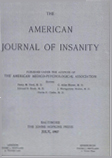HEMATOPORPHYRIN AS A THERAPEUTIC AGENT IN THE PSYCHOSES
Abstract
(1) Hematoporphyrin has a marked photosensitizing power when injected into the human body. The synthetic product, hematoporphyrin hydrochloride (" Photodyn ") has been demonstrated to possess greater photosensitizing power than the compound endogenously produced through disease.
(2) Experimentally the drug has been shown to produce alteration in the blood electrolyte values—chiefly calcium. The only one of our patients in whom blood calcium studies were made showed a definite fall in blood calcium during and after hematoporphyrin therapy.
(3) Results of animal experimentation seem to show that increased physiologic and psychologic drive results from enteral and parenteral administration of synthetic hematoporphyrin.
(4) Hematoporphyrin as a therapeutic agent in the depressive psychoses is reported in foreign literature to be successful in a large majority of cases. So far as we know, no carefully controlled study has yet been done in any substantial number of cases.
(5) Thirty-seven patients were studied in our series to determine their responses to hematoporphyrin administration. Twenty-three patients with manic-depressive reactions were treated during the depressed phase with intramuscular and oral administration of hematoporphyrin hydrochloride for an average period of 50 to 6o days. Of this number five showed marked sustained improvement, six showed moderate sustained improvement, and six were generally benefited but the course of the psychosis did not seem to be positively affected. Six gave no favorable response. Seventeen patients of 23 can be said to have been definitely helped by the treatment.
(6) Four of eight patients suffering from involutional melancholia showed marked improvement which has been maintained after the treatment was terminated. One was moderately improved and has maintained this gain. Two were generally better during and after treatment but have not made complete recoveries. Only one failed to respond favorably.
(7) One schizophrenic of six treated made substantial physical gains, remains generally better and has adjusted his life at a considerably lower level but is working steadily. Definite stimulation ınd animation were evident in all of the schizophrenics treated but in five of these patients the reaction was not of constructive nature. These five subsided into passive states after the treatment was discontinued.
(8) It is evident from our experience with hematoporphyrin that when administered to psychotic patients the substance in some way increases the available energy of the individual. The explanation of the mechanism of improvement will have to await more detailed studies. It is significant, however, whatever the physiologic action, that actual somatic and psychic benefits seem to be derived from its administration.
Access content
To read the fulltext, please use one of the options below to sign in or purchase access.- Personal login
- Institutional Login
- Sign in via OpenAthens
- Register for access
-
Please login/register if you wish to pair your device and check access availability.
Not a subscriber?
PsychiatryOnline subscription options offer access to the DSM-5 library, books, journals, CME, and patient resources. This all-in-one virtual library provides psychiatrists and mental health professionals with key resources for diagnosis, treatment, research, and professional development.
Need more help? PsychiatryOnline Customer Service may be reached by emailing [email protected] or by calling 800-368-5777 (in the U.S.) or 703-907-7322 (outside the U.S.).



